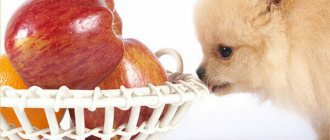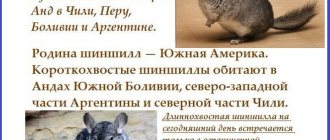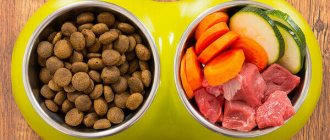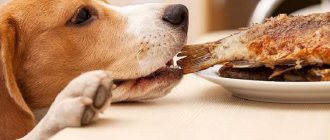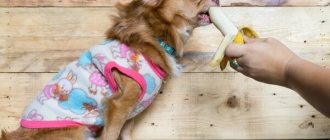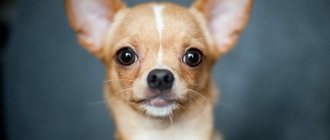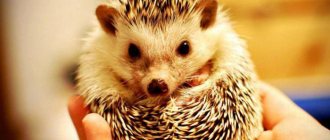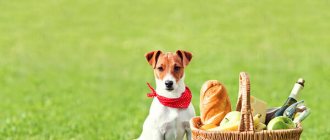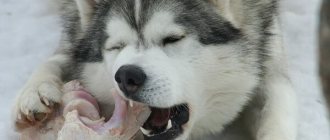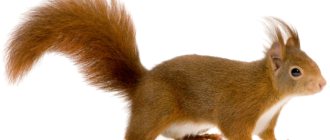The quality of a dog's nutrition largely determines its appearance, health and life expectancy.
Thus, chow chows’ bodies do not digest fatty foods well, and due to excess carbohydrates, they gain excess weight, which can cause problems with the heart and musculoskeletal system.
Therefore, it is important to correctly create a pet’s diet, taking into account not only the volume of portions and the number of feedings, but also foods that are prohibited or, on the contrary, necessary for its healthy growth and development.
Natural food or artificial food?
Like dogs of other breeds, Chow Chows can be fed both natural products and industrial food. Each type of nutrition has pros and cons, so it is impossible to definitively answer which one is better.
Choosing a pet’s diet is the owner’s responsibility.
The only thing we can say with certainty is that when composing a diet, it is necessary to monitor its balance and take into account the dog’s age, health status and level of physical activity.
A natural menu allows the owner to independently control the quality and freshness of the food consumed by the pet, however, it takes quite a lot of time to prepare food.
In turn, industrial food is sold ready-made and has a balanced composition that takes into account the needs of the dog, which greatly facilitates the task of its owner.
You cannot mix both types of food, since the animal’s body produces different enzymes to process natural products and feed..
Expert opinion
Kozhevin Semyon Kirillovich
Expert dog handler.
A natural diet has many advantages: it does not contain chemical flavorings or taste enhancers, nutrients of natural origin are better absorbed by the animal’s body, and such nutrition will cost the owner much less than industrial feed. However, many dog breeders believe that with a natural diet, a dog can be given almost anything, including leftovers from the common table. This opinion is wrong and can lead to serious health problems for your pet. Most breeders prefer to feed dogs with ready-made food because it is more convenient, easier and faster, and the likelihood of negative consequences if high-quality products are used is extremely low.
The variety of tastes in the assessment of dog lovers
Most of the products in the line can be used for all dogs without restrictions, but there are also several products for animals with special needs:
- For dogs prone to an active lifestyle. They are offered food with chicken.
- For animals suffering from diseases of the digestive tract. Products with salmon will suit them.
This division is positively assessed by dog owners, as it helps to identify and purchase a product that is best suited.
The Dog Chow flavor line includes four of the most popular delicacies: chicken, lamb, turkey and salmon. Consumers note that these, of course, are the most common options, but the same ProPlan food has much more flavors, and also contains beef, which is so valued by dog breeders in the diet of their pets.
Pros and cons of natural food
In addition to the fact that with this type of feeding the owner has the opportunity to independently choose only high-quality and fresh products for the pet, a natural diet has a number of other significant advantages:
- the absence of chemical flavors, dyes and taste enhancers, which not only do not benefit the animal, but can also harm it;
- if an allergic reaction occurs to one of the products, it can be excluded from the menu without changing the dog’s diet as a whole;
- vitamins and minerals necessary for the health and development of your pet are of natural origin and are better absorbed.
A significant advantage is the opportunity to save on feeding your pet by purchasing seasonal vegetables and fruits and alternating beef or veal with chicken.
Disadvantages of this type of nutrition:
- it is impossible to create a balanced diet without certain knowledge of veterinary nutrition;
- Your pet needs to cook every day - stale food does not retain useful components, and it can also cause poisoning or other problems with the gastrointestinal tract;
- cooking takes quite a long time;
- For people who often travel with a pet, such a diet presents additional difficulties and inconveniences.
With a natural diet, it is necessary to take a vitamin-mineral complex.
Authorized Products
Representatives of this breed must include in their menu:
- lean meats;
- offal;
- fermented milk products with low fat content;
- cereals;
- vegetables;
- fruits;
- greenery;
- boiled chicken eggs;
- sea and ocean lean fish.
As a treat or reward during training, you can give your pet some nuts or hard cheese, and to prevent the formation of plaque and tartar - raw beef bones.
What is prohibited
You can't give chow chow:
- potato;
- legumes;
- corn;
- pasta;
- pearl barley, corn, barley;
- candies, chocolate and other sweets;
- salo;
- smoked meats, canned food, sausages;
- river fish;
- pollock;
- capelin;
- fat meat;
- tubular bones;
- semi-finished products;
- pickles, marinades;
- yeast baked goods;
- exotic fruits and berries.
Adult dogs should not be given milk due to lactose intolerance.
Natural nutrition
The puppy tries adult food while being close to its mother. Usually, at 2 months, babies willingly drink milk and even chew minced meat. If the breeder adheres to industrial nutrition, the puppies receive wet food (pates). At 3 months, the baby moves to a new home, which is associated with severe stress. To facilitate adaptation, the pet’s diet and daily routine do not change for 7–10 days. Afterwards, the Chow Chow's nutrition is completely under the control of the new owner. If you choose “natural”, the ward’s menu expands to the following set of products:
- Meat (beef, less often poultry without skin and bones).
- By-products (10–15% of meat can be replaced) – heart, stomach (rumen), liver, lungs, trachea, cartilage.
- Milk and dairy products - homemade yogurt, kefir, yogurt, cottage cheese (preferably calcined).
- Eggs – several per week, only boiled for puppies.
- Cereals – wheat, barley, rice, buckwheat. Barley is indicated for dogs that quickly gain weight. Corn grits are neither harmful nor beneficial.
- Vegetables - sweet peppers, tomatoes, cucumbers, zucchini, radishes, cabbage (not raw), carrots, beets (not a lot).
- Fruits - apples, pears, some bananas, berries, nuts.
Whether an adult Chow Chow should be fed dairy products or pork is up to you to decide. Let us only point out the fact that fatty meat is contraindicated for dogs, and lean pork must be boiled or deep-frozen (it may contain the false rabies virus).
Lactose intolerance is not a fiction, but in fact, this trait is characteristic of some (not all) dogs. If your pet begins to have diarrhea after a bowl of milk, it is most likely worth switching your pet to fermented milk products.
Sample menu for the week
| Days of the week | Product Set |
| Monday | 300 g cottage cheese, 400 g beef, 100 g vegetables with rice porridge |
| Tuesday | 1 egg, 300 ml natural yogurt, 100 g buckwheat porridge with vegetables, 500 g fish |
| Wednesday | 300 ml kefir, 340 g veal, 60 g offal, 100 g wheat porridge with vegetables |
| Thursday | 300 g cottage cheese, 400 g turkey, 100 g vegetables with buckwheat porridge |
| Friday | 1 egg, 300 g cottage cheese, 340 g beef, 60 g offal, 100 g vegetables with rice |
| Saturday | 300 ml natural yogurt, 500 g fish, 100 g vegetables with buckwheat |
| Sunday | 300 g cottage cheese, 400 g veal, 100 g vegetables |
You should also give your chow chow vegetable oils, but not more than 1 tbsp. l. per day .
Super premium
The product descriptions in the annotations will help you decide on the composition that is most suitable for your pet.
Fest Choice
Trainer
Arden Grange
Gina Elite
Porclean
Brit Care
Daily Dog
Industrial feed
Nutrition based on industrial feeds also has advantages and disadvantages.
The advantages of such a diet include:
- ease of storage, use and dosing;
- balanced composition, taking into account the characteristics of the breed and enriched with all necessary vitamins, macro- and microelements;
- the ability to select food that takes into account the physiological characteristics of the pet;
- saving time on preparing food for the dog;
- long shelf life, allowing you to buy food for the animal for future use.
In addition, the special composition with which dry food granules are coated serves as a means of preventing the formation of plaque and tartar.
CAREFULLY!
The significant disadvantages of such a diet are that good food is quite expensive, and cheap products most likely contain low-quality meat or offal, as well as artificial colors, flavors and flavor enhancers.
You should also understand that if an allergic reaction occurs to one of the components of the food, you will need to completely change the chow chow's diet.
Industrial food includes not only dry food, but also wet food . They differ in that they contain up to 80% liquid, which makes them less nutritious, but more beneficial for the gastrointestinal tract of dogs.
The fact that products of different quality are used to make feed leads to the division of products into several classes:
- economy - the composition contains low-quality products, flavors, preservatives, flavor enhancers, dyes, there is a possibility of containing soy and beans;
- premium - the composition is based on meat, offal and vegetables, but it is unlikely that it contains vitamins and minerals;
- super-premium - only the highest quality products are used to make such food; it contains vitamins and all the necessary macro- and microelements.
In addition, almost all brands have a line of holistic foods, the composition of which is as close as possible to the natural diet.
It is also possible to choose hypoallergenic food, food for dogs with sensitive digestion, pregnant and lactating bitches, and elderly animals.
Character of the Chow Chow
The original appearance of the animal is combined with some features of its mentality. A gloomy expression on the muzzle can create a false impression of the dog's arrogance and heartlessness. Reviews from owners claim that the Chow Chow is a breed devoted to humans. Other character traits that the future owner of a four-legged animal should know about:
- Restraint in expressing feelings, balance.
- Loyalty to only one owner, whom the Chow Chow recognizes as the leader.
- Will not tolerate excessive and active affection from children, which their parents should take into account.
- Friendliness to pets that live in the same area. With the exception of dogs not related to their breed.
- Dogs are wary of strangers, but will not show aggression without a reason.
How to choose a Chow Chow puppy?
Before purchasing a baby of this breed, you need to decide what it is for. If Chow Chow puppies are bred for further participation in exhibitions and championships, then they must fully comply with exterior standards. Companion dogs or just family pets may have some disqualifying characteristics: floppy ears, a spotted tongue, an overbite and a narrow chest.
Males are most suitable as exhibition specimens. Males better correspond to all parameters of the breed and look more impressive. Female Chow Chows make good companions. They are very gentle and affectionate. Their affection for humans is more pronounced than that of males. Other features to choose from:
- Purchase a puppy only with a veterinary passport, which indicates comprehensive vaccination. Vaccinations are given at 4 weeks and one and a half months, and then every year.
- The baby's mouth and tongue should be blue-black. By two months the ears are almost completely raised.
- Before buying, you should observe the behavior of the Chow Chow puppy. Representatives that are too cowardly or aggressive should be rejected.
- Eyes and ears should be clean, without purulent discharge or redness.
- How much a Chow Chow costs can be judged by the offers of official breeders of the breed. The most expensive are the future champions. Their price can reach $380-470. Puppies with exterior defects will cost less. They sell for $70-100.
Top 7 rating
Only high-quality products, not lower than premium, and preferably super-premium or holistic food, are suitable for feeding chow chows.
Most popular foods:
- Brit . Super premium food. Contains lamb meat and rice. Contains vitamins, herbal extracts and chondroprotectors to prevent joint problems.
- Now . Super premium products. The composition is based on hypoallergenic turkey meat, instead of cereal porridge it contains dried vegetables and fruits, and is also enriched with vitamins and lactobacilli.
- Belcando . German-made canned food, the main component of which is turkey meat. The gravy contains rice and vegetables. In addition to the standard set of vitamins, canned food also contains calcium, fluoride, and lecithin.
- Acana . They contain natural meat and fresh vegetables, and the food lines intended for large breeds of dogs contain almost no carbohydrates.
- Purina ProPlan - despite the fact that the food belongs to the premium category, it contains flavorings and taste enhancers that can provoke an allergic reaction.
- Nutram is a high-quality food made from selected natural products with quality certificates.
- Happy Dog has both premium and economy class food, so it is important to carefully study the composition. The advantage of Happy Dog food is that at a fairly low cost, many lines are not inferior in quality to food brands such as Hills or ProBalance.
Dry food should be given to adult dogs in solid form, while puppies should be soaked in water or milk.
What foods can cause an allergic reaction?
Dogs are most often susceptible to food allergies. Such a reaction can be triggered by any food product; one animal may become allergic to a certain brand of dry food, while another may be allergic to beef or carrots.
There is no specific list of foods that can cause allergic reactions; the nutrition of each dog should be individual; you just need to recognize the food that causes an allergic reaction in time and remove it from your pet’s diet.
But there are still a number of food products to which the animal body most often reacts as an allergen.
- Dry food. Artificial additives, substitutes and dyes, which are present in large quantities in dry food, are components that often cause allergies in dogs. Less commonly, an allergic reaction occurs to soy, cereals and milk powder, which are also components of dry food.
- Chicken meat Recently, pets are becoming more and more allergic to chicken, due to the unscrupulous behavior of chicken meat producers. Potent antibiotics and growth hormones are often introduced into the poultry diet, which can accumulate; the allergenic effect of eating such meat can manifest itself in a dog.
- Egg. An owner who feeds his pet chicken eggs must be prepared for the dog to begin to suffer from an allergy to chicken protein. This delicacy can also be classified as a product that often causes skin manifestations of the disease.
- Fruits and vegetables are red. Dermatitis caused by eating such vegetables and fruits is less common than a reaction to protein. Small dogs that enjoy eating fruit often suffer from this type of allergy.
- Fish and seafood. Before feeding your dog mussels or shrimp, it is worth remembering that such products cause allergic reactions in many people, not to mention animals.
- Products that are harmful to animals and should not be given to your pet. Every dog owner knows about chocolate, sugar, pastries, fried foods and smoked meats. Any product listed is extremely allergenic for furry pets. There is no need to follow the lead of a dog begging for such treats; it is better to give him a special treat purchased at a pet store.
- Beef. This meat extremely rarely causes allergic reactions, just don’t feed it constantly, the dog’s diet should be varied. A mono-diet (feeding only one type of food) can ultimately lead to the development of a variety of diseases.
How to feed a puppy correctly?
The table shows the approximate diet of Chow Chow puppies by month.
| Age | Approximate diet | Number of feedings |
| 1-2 months | 100-200 g finely chopped beef, 50-100 g calcined cottage cheese, 100 g milk porridge, 1 tsp. fructose, 1 yolk, 60-100 g kefir, 50-100 g porridge in meat broth, 50 g vegetables | 6 |
| 2-3 months | 200-300 g of meat, 100 g of calcined cottage cheese, 100-200 g of porridge in broth, 100 g of kefir, 100 g of vegetables and herbs, 1 yolk | 5 |
| 4-5 months | 300-400 g of meat, 200 g of porridge in broth, 200 g of calcined cottage cheese, 200 g of kefir or fermented baked milk, 200 g of vegetables | 4 |
| 5-6 months | 500 g meat, 200-300 g porridge in broth, 200-300 g cottage cheese, 200 g kefir or fermented baked milk, 200 g vegetables, 400-500 g fish, 2-3 g brewer's yeast | 4 |
| 6-10 months | 400 g meat, 200 g porridge in broth, 200 g cottage cheese, 200 g kefir or fermented baked milk, 200 g vegetables, 400-500 g fish, 2-3 g brewer's yeast | 3 |
How and what to feed an adult dog?
When compiling a menu for a chow chow, it is important to take into account many factors, which determine not only the number of feedings and the daily volume of food, but also the rate of consumption of fats, carbohydrates, proteins, minerals and vitamins.
So, a dog needs different amounts of food in summer and winter, caloric content can vary depending on the physiological state of the animal and its level of physical activity, and in the diet of older chow chows the amount of carbohydrates needs to be reduced by about 20%.
IMPORTANT!
An adult pet needs to be fed twice a day, once it reaches the age of 6-7 years - once.
Approximately ⅔ of the daily diet should be allocated to meat and offal and ⅓ to cereals, vegetables and dairy products.
You should not feed your pet before a walk, as it takes several hours for him to digest food calmly. Also, you should not give your dog food that is cold or too hot.
It is better to give cottage cheese, kefir or other fermented milk products to the animal in the first half of the day, and leave the main feeding, including meat, cereals, vegetables, for the evening.
When feeding industrial food, it is also necessary to take into account all the pet’s characteristics and adhere to the manufacturer’s recommendations indicated on the packaging.
Briefly about the main thing
- The Chow Chow is a companion dog with exterior characteristics: thick coat with undercoat, fluffy tail, neat ears. Amenable to training and education.
- In order to achieve results in raising a dog, you need not only training, but also a diet and rest.
- When feeding, it is important to avoid life-threatening foods: fatty, sweet foods, enhancers, chemical components.
- Only the owner will have to decide which food is suitable. Experienced veterinarians, dog breeders, and breeders will help.
- A properly selected menu is the key to longevity, activity, and obedience of your pet.
What do you feed your pet? Share your recipes and diet in the comments.
Did you like the article? Share it with your friends on social media. networks. This will help them get useful information and support our project.
